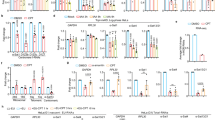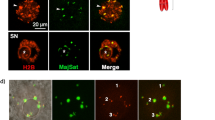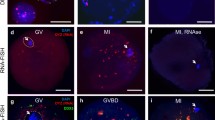Abstract
During the lampbrush stage of oogenesis there is widespread transcription, and it has been estimated that the total amount of DNA transcribed may be an order of magnitude greater than that required to produce the necessary functional RNA for the oocyte1. We therefore considered it likely that some of the transcribed sequences have little, if any, translational significance, and may include both middle repetitive2 and highly repeated, or satellite, sequences. Satellite DNA is generally defined as rapidly reannealing DNA which has a short basic sequence that is repeated millions of times in the genome, usually in tandem arrays3,4. The short repeated length, coupled with the organisation of satellite sequences in high order molecular weight tandem arrays in heterochromatic regions, have been put forward as reasons for supposing that this type of DNA is not normally transcribed5. We report here that we have looked for and found evidence of transcription of satellite DNA on lampbrush loops in oocytes of the crested newt, Triturus cristatus carnifex.
This is a preview of subscription content, access via your institution
Access options
Subscribe to this journal
Receive 51 print issues and online access
$199.00 per year
only $3.90 per issue
Buy this article
- Purchase on SpringerLink
- Instant access to full article PDF
Prices may be subject to local taxes which are calculated during checkout
Similar content being viewed by others
References
Sommerville, J. Int. Rev. Biochem. 15, 79–156 (1977).
Macgregor, H. C. & Andrews, C. Chromosoma 63, 109–126 (1977).
Davidson, E. H. Gene Activity in Early Development (Academic, New York, 1976).
Appels, R. & Peacock, W. J. Int. Rev. Cytol. Suppl. 8, 69–126 (1978).
Bostock, C. J. & Sumner, A. T. The Eukaryotic Chromosome (North Holland, Amsterdam, 1978).
Pukkila, P. J. Chromosoma 53, 71–89 (1975).
Macgregor, H. C. Chromosoma 71, 57–64 (1979).
Bolivar, F. et al. Gene 2, 95–113 (1977).
Boyer, H. W. & Roulland-Dussoix, D. J. molec. Biol. 41, 459–472 (1969).
Southern, E. M. J. molec. Biol. 98, 503–517 (1975).
Macgregor, H. C. & Mizuno, S. Chromosoma 54, 15–25 (1976).
Hennen, S., Mizuno, S. & Macgregor, H. C. Chromosoma 50, 349–369 (1975).
Varley, J. M., Macgregor, H. C., Nardi, I., Andrews, C. & Erba, H. P. Chromosoma (in the press).
Mancino, G., Ragghianti, M. & Bucci-Innocenti, S. in The Reproductive Biology of Amphibians (eds Taylor, D. H. & Guttman, S. J.) (Plenum, New York, 1977).
Morgan, G. T. Chromosoma 66, 269–280 (1978).
Callan, H. G. & Lloyd, L. Phil. Trans. R. Soc. Lond. B243, 135–219 (1960).
Macgregor, H. C. & Horner, H. A. Chromosoma (in the press).
Clewell, D. B. J. Bact. 110, 667–676 (1972).
Clewell, D. B. & Helinski, D. R. Biochemistry 9, 4428–4440 (1970).
Author information
Authors and Affiliations
Rights and permissions
About this article
Cite this article
Varley, J., Macgregor, H. & Erba, H. Satellite DNA is transcribed on lampbrush chromosomes. Nature 283, 686–688 (1980). https://doi.org/10.1038/283686a0
Received:
Accepted:
Issue date:
DOI: https://doi.org/10.1038/283686a0
This article is cited by
-
New high copy tandem repeat in the content of the chicken W chromosome
Chromosoma (2018)
-
Non-coding RNA derived from a conservative subtelomeric tandem repeat in chicken and Japanese quail somatic cells
Molecular Cytogenetics (2014)
-
Cytological maps of lampbrush chromosomes of European water frogs (Pelophylax esculentuscomplex) from the Eastern Ukraine
BMC Genetics (2013)
-
Are lampbrush chromosomes unique to meiotic cells?
Chromosome Research (2012)
-
Genome-wide transcription and the implications for genomic organization
Nature Reviews Genetics (2007)



